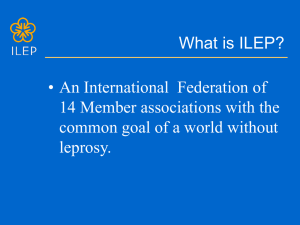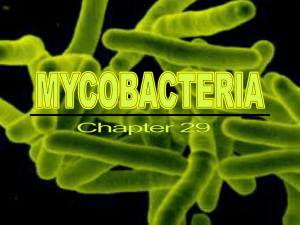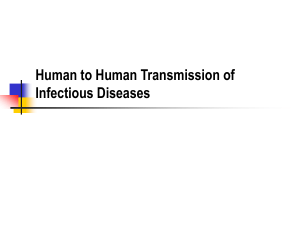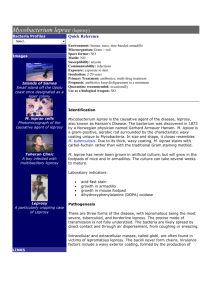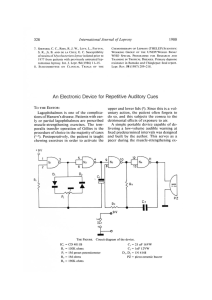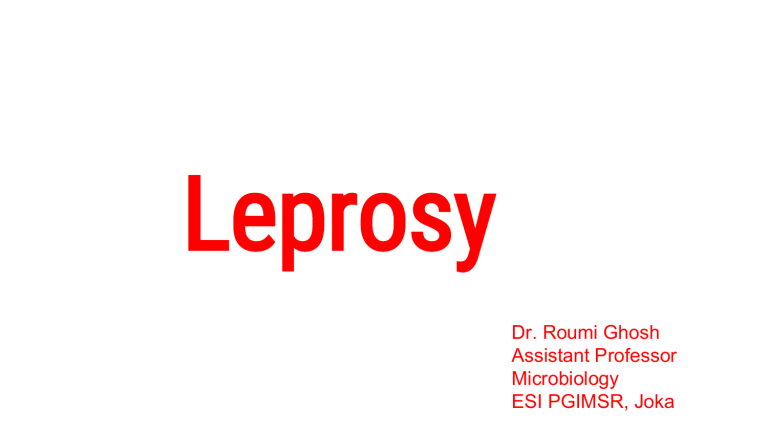
Leprosy Dr. Roumi Ghosh Assistant Professor Microbiology ESI PGIMSR, Joka INTRODUCTION ▰ Mycobacterium leprae - causative agent of leprosy; a disease of antiquity, having been recognized since long time : Vedic times in India (described as Kushta Roga in Sushruta Samhita, 600 BC) Biblical times in the Middle East Hippocrates, 460 BC. 2 INTRODUCTION (Cont..) ▰ G. H. Armauer Hansen (1873) - discovery of lepra bacilli ▰ Shepard (1960) – multiplying lepra bacilli in footpads of mice kept at a low temperature (20°C). 3 CLINICAL MANIFESTATIONS ▰ Chronic granulomatous disease of humans - involving cooler parts of the body (skin, peripheral nerves, upper respiratory tract, eyes, and testes, etc.). ▰ Capable of affecting any tissue or organs causing bony deformities and disfigurements in untreated cases. 4 CLINICAL MANIFESTATIONS ▰ Incubation period: long incubation period - 5–7 years (vary between 2 and 40 years) ▰ Attributed to longer generation time of lepra bacilli - 12–13 days as compared to 14 hours for tubercle bacillus. ▰ Lepromatous cases - longer incubation period than tuberculoid cases. 5 Classification of Leprosy Ridley-Jopling classification Madrid classification (1953) Indian classification (1981) Lepromatous leprosy (LL) Lepromatous type Lepromatous type Borderline Lepromatous leprosy Borderline Borderline Borderline leprosy (BB) Indeterminate type Indeterminate type Borderline tuberculoid leprosy (BT) Tuberculoid type Pure neuritic type Tuberculoid leprosy (TT) — Tuberculoid type (1966) (BL) 6 Clinical Classification ▰ Paucibacillary (PB) leprosy: A case of leprosy which fulfills all the criteria— (i) 1 to 5 skin lesions, (ii) no nerve involvement, and (iii) slit-skin smear negative for lepra bacilli 7 Clinical Classification (Cont..) ▰ Multibacillary (MB) leprosy: A case of leprosy which fulfills any one of the criteria— (i) >5 skin lesions; or (ii) nerve involvement (neuritis); or (iii) slit-skin smear positive for lepra bacilli. 8 Characters Lepromatous leprosy (ll) Tuberculoid leprosy (TT) Differences between lepromatous leprosy and Multibacillary Paucibacillary tuberculoid leprosy Bacillary load Bacteriological index 4–6+ 0–1+ Skin lesions Many, symmetrical Margin is irregular Lesions appear as: Multiple nodules (lepromata) Plaques and xanthoma-like papules Leonine facies and eyebrow alopecia One or few, asymmetrical Margin is sharp Lesions appear as: Hypopigmented, annular macules with elevated borders Tendency towards central clearing 9 Characters Lepromatous leprosy (ll) Tuberculoid leprosy (tt) Differences between lepromatous leprosy and Nerve lesion Nerve lesions appear late Early anesthetic skin lesion, tuberculoid leprosy (Cont..) Hypoesthesia is a late sign Enlarged thickened nerves, Variable nerve palsies Nerve abscess seen (common in BT) CMI Low Normal Lepromin test Negative Positive Humoral immunity Exaggerated Normal Macrophages Foamy type (lipid- laden) Epithelioid type Langhans giant cells Not seen Found 10 Differences between lepromatous leprosy and tuberculoid leprosy (Cont..) A B A. Nodular lesions of lepromatous leprosy; B. Hypopigmented skin lesions of tuberculoid leprosy (arrow showing). 11 COMPLICATIONS ▰ Complications in leprosy patients may be of two types— Deformities and Allergic response (called lepra reactions). 12 Deformities ▰ 25% of untreated cases develop deformities - may arise due to— (1) nerve injury - muscle weakness or paralysis, or (2) disease process (facial deformities or loss of eyebrow), or (3) infection or injury (ulcers). 13 Deformities (Cont..) Common deformities include: ▰ Face: Leonine facies, sagging face, loss of eyebrow/eye lashes, saddle nose and corneal opacity and ulcers ▰ Hands: Claw hand and wrist drop ▰ Feet: Foot drop, clawing of toes, inversion of foot, and plantar ulcers. 14 Deformities (Cont..) Deformities seen in untreated lepromatous leprosy: A. Saddle nose deformity; B. Bony deformity; C. Corneal opacity. 15 Characters Lepra reaction type I Lepra reaction typeII Hyper- sensitivity Type IV (delayed hypersensitivity) Lepra Reactions Type III (immune complexmediated) Seen with Borderline leprosy Lepromatous variety (BL, LL) Manifests as Inflammation of previous lesions, new skin lesions and neuritis Crops of painful erythematous papules which become nodular called ENL Progresses as If occurs before treatment It usually occurs following —progresses towards LL (down grading the start of chemotherapy reaction) If occurs after treatment— progresses towards TT (reversal reaction) 16 Characters Lepra reaction type I T-helper TH1 predominates leads to Lepraresponse Reactions (Cont..) IFN-g and IL-2 Lepra reaction typeII TH2 predominates-leads to IL-6, IL-8. TNF-α plays a central role Other organs Usually not affected Eyes, testes and kidney are affected Treatment Glucocorticoid Glucocorticoid, thalidomide, clofazimine and antipyretics 17 EPIDEMIOLOGY Source of infection: ▰ Multibacillary (LL and BL) cases - most important sources of infection. ▰ Asymptomatic cases - have a role in transmission. ▰ Tuberculoid leprosy - do not transmit infection efficiently 18 EPIDEMIOLOGY (Cont..) Mode of transmission: ▰ Nasal droplet infection (aerosols containing M. leprae) - most common mode. ▰ Contact transmission (skin): Direct contact from person to person Indirect contact with infected soil, fomites - clothes and linens. ▰ Direct dermal inoculation during tattooing. 19 EPIDEMIOLOGY (Cont..) ▰ Communicability: Leprosy - not highly communicable - Intimate and prolonged contact - necessary for transmission. ▰ Environmental factors - people of rural areas, moist soil, humidity and overcrowding. 20 Leprosy Elimination ▰ In 1992 - WHO launched a campaign to eliminate leprosy as a public health problem by year 2000. ▰ Goal - <1 case per 10,000 population. ▰ India: Achieved the elimination status by December 200. ▰ Global Leprosy Strategy (2016-20): Launched by WHO in 2016 - aims at reducing disability among children by 2020 21 Geographical Distribution ▰ Once leprosy was worldwide in distribution – now almost exclusively confined to the developing nations like India Africa , Latin America etc. ▰ India: ▰ As of 31st March 2018 - 90,709 cases are on record in India. ▰ Five states/UTs reported prevalence above elimination cut-off of >1/10,000 population as on 31st March. 22 1. Smear Microscopy ▰ Smear microscopy - done to demonstrate the acid-fast bacilli in the lesions. 23 Specimen Collection Total six samples are collected: ▰ Four from skin (forehead, cheek, chin and buttock), ▰ One from ear lobe and nasal mucosa by nasal blow/scraping. Click to add text Slit skin smear - collect skin and ear lobe specimens . Nasal specimens: Nasal blow - early morning mucus material Nasal scraping - mucosal scraper to scrape the nasal septum 24 Appearance ▰ Less acid-fast - stained by Ziehl–Neelsen technique - 5% sulfuric acid for decolorization. ▰ Under oil immersion - red acid-fast bacilli, arranged singly or in groups (cigar like bundles). ▰ Virchow’s lepra cells or foamy cells 25 Appearance (Cont..) ▰ Live bacilli - uniformly stained with parallel sides and round ends and length is five times the width ▰ Dead bacilli - less uniformly stained and have fragmented and granular appearance. 26 Grading of the Smear ▰ 1–10 bacilli in 100 OIF =1+ ▰ 1–10 bacilli in 10 OIF = 2+ ▰ 1–10 bacilli per OIF = 3+ ▰ 10–100 bacilli per OIF = 4+ ▰ 100–1000 bacilli per OIF = 5+ ▰ >1000 bacilli or bacilli in clumps and globi in each OIF = 6+ 27 Grading of the Smear (Cont..) ▰ Bacteriological index (BI): Total number of bacilli (live and dead) per oil immersion field ▰ Morphological index (MI): Percentage of uniformly stained bacilli out of the total number of bacilli counted MI is a better marker to monitor the treatment response 28 2. Mouse Foot Pad Cultivation ▰ Not cultivable either in artificial culture media or in tissue culture. ▰ Only certain way - by inoculating the specimens into foot pad of mice and keeping at 20°C for 6–9 months. ▰ Other animals - nine banded armadillo (Dasypus novemcinctus) - also used. 29 2. Mouse Foot Pad Cultivation (Cont..) ▰ Advantages: 10 times more sensitive than microscopy Detecting drug resistance & Evaluating potency of drugs detects viability of bacilli ▰ Disadvantages: Time-consuming (6–9 months) & ethical issues 30 3. Antibody Detection ▰ FLA-ABS (Fluorescent leprosy antibody absorption test): To identify subclinical cases Antibodies detected irrespective of duration and stage of the disease 92% sensitive and 100% specific 31 3. Antibody Detection (Cont..) ▰ ELISA detecting IgM antibodies to PGL-1 (phenolic glycolipid-1) antigen of M. Leprae - found in 95% of patients with untreated LL patients & titre decreases with effective therapy 32 4. Test for Detecting CMI (Lepromin Test) ▰ Demonstrates delayed hypersensitivity reaction against the lepra antigen. ▰ Also indicates an intact host’s CMI. ▰ Procedure: Lepromin antigen - injected intradermally to forearm and reading is taken at two occasions. 33 4. Test for Detecting CMI (Lepromin Test) (Cont..) ▰ At 48hr (Early or Fernandez reaction): Induration (>10 mm) - corresponds to DTH reaction to lepra antigen and indicates past exposure to lepra bacilli. ▰ At 21 days (Late or Mitsuda reaction): A nodule of >5 mm – subsequently ulcerates If positive - patient’s CMI is intact If negative - absence of CMI 34 Treatment of Leprosy ▰ Recommended drugs: Dapsone, rifampicin and clofazimine ▰ Alternate drugs: Ethionamide, quinolones (ofloxacin), minocycline and clarithromycin. 35 Treatment of Leprosy (Cont..) ▰ WHO Regimen (2018) ▰ 3-drug regimen: WHO recommends a 3-drug regimen of rifampicin, dapsone and clofazimine for all leprosy patients. Dapsone (100 mg) - daily, self-administered Rifampicin (600 mg) - once a month under supervision Clofazimine (300 mg) - once a month under supervision, and by 50 mg daily, self-administered 36 Treatment of Leprosy (Cont..) ▰ Duration of treatment—6 months for paucibacillary leprosy and 12 months for multibacillary leprosy ▰ Follow-up - annually for 2 years for paucibacillary leprosy and for five years for multibacillary leprosy. 37 PREVENTION OF LEPROSY ▰ Active case finding and effective treatment of cases. ▰ BCG vaccine: No effective vaccine available so far. ▰ MIP vaccine: Killed leprosy vaccine - developed in India in 2018, using Mycobacterium indicus pranii (MIP). 38 PREVENTION OF LEPROSY (Cont..) ▰ Chemoprophylaxis: Dapsone – to high-risk household contacts of tuberculoid patients, but not for lepromatous patients; hence not recommended ▰ Hospitalized patients need not be isolated as transmission requires prolonged contact. 39 Questions: ▰ Q1. The generation time of lepra bacilli is: a. 20 minutes b. 2 hours c. 20 hours d. 12-13 days 40 Questions: ▰ Q2. Correct about lepromatous leprosy: a. Multibacillary b. CMI is normal c. Langerhans cells are found d. Positive lepromin test 41
